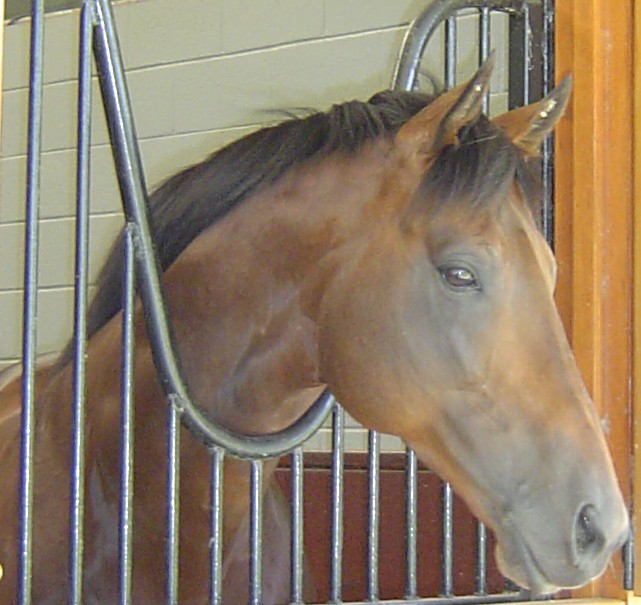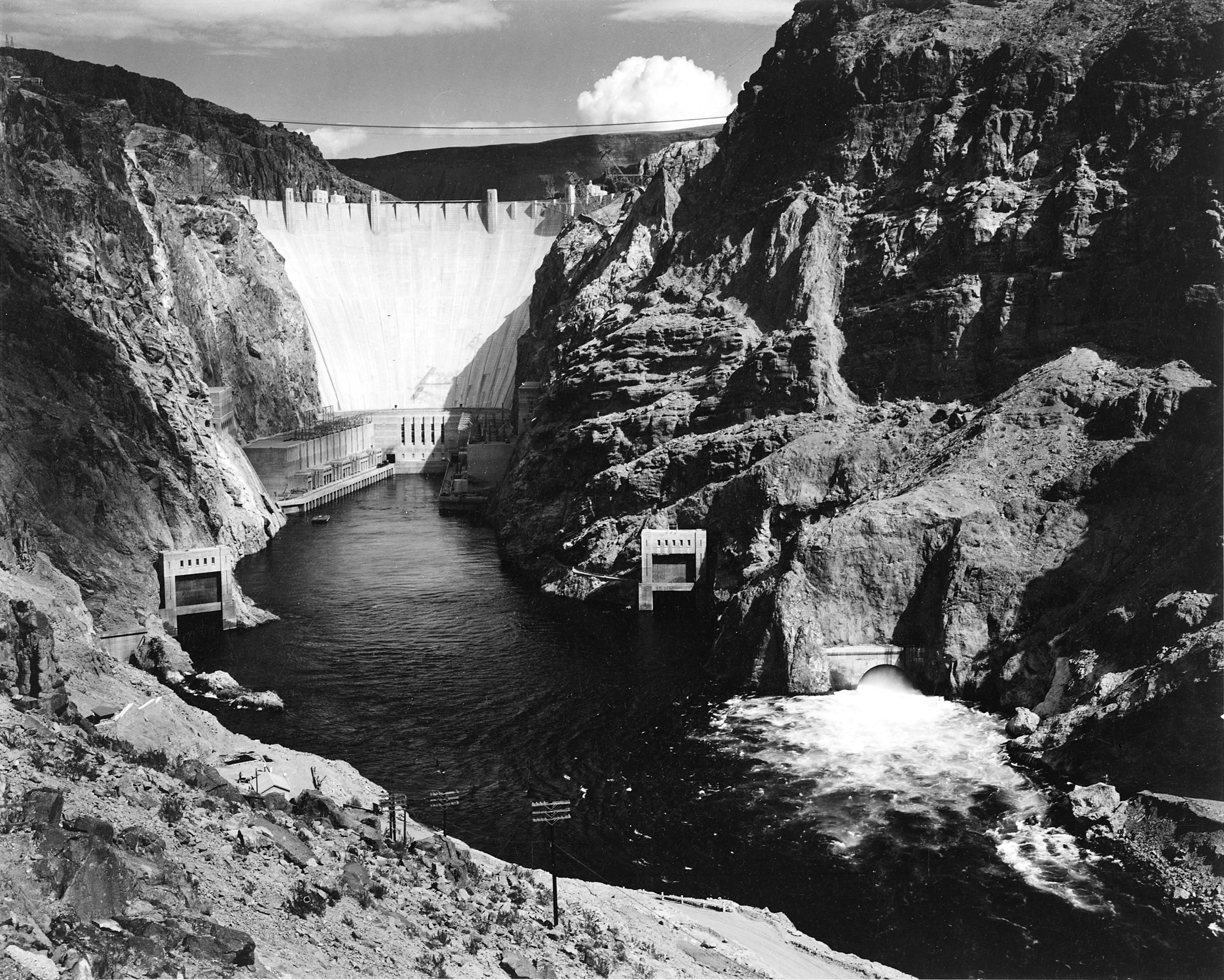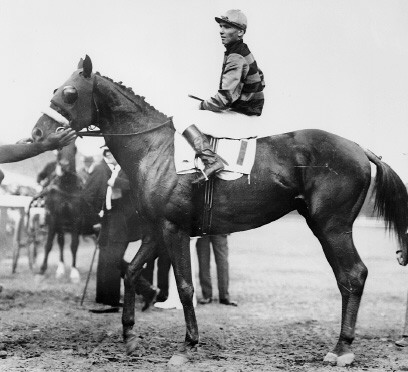|
Platter (horse)
Platter (foaled 1941 in Kentucky) was an American Thoroughbred Champion racehorse. He is best known for his performances as a two-year-old in 1943, when he was the best American colt of his generation. Background He was bred and raced by George D. Widener Jr., and conditioned for racing by future U.S. Racing Hall of Fame trainer Bert Mulholland, Racing career In 1943 he won the Pimlico Futurity and the Walden Stakes under jockey Conn McCreary and was voted American Champion Two-Year-Old Colt by Daily Racing Form. The rival Turf & Sports Digest Magazine poll was topped by Occupy. As a three-year-old, an injury kept Platter out of racing until early May in an allowance race test. The colt did not run in the 1944 Kentucky Derby but finished second to Pensive in the second leg of the U.S. Triple Crown series, the Preakness Stakes. He was injured in the Belmont Stakes and had to be pulled up. Stud career Retired to stud duty, Platter met with limited success. Of his limited ... [...More Info...] [...Related Items...] OR: [Wikipedia] [Google] [Baidu] |
Friar Rock
Friar Rock (1913 – January 8, 1928) was a Champion American Thoroughbred racehorse. His most important win came in the 1916 Belmont Stakes. Background Owned and raced by the prominent New York City businessman August Belmont Jr., he was foaled at Belmont's Nursery Stud near Lexington, Kentucky. A chestnut colt with inherited Bend-Or spotting, he was out of Belmont's imported English dam Fairy Gold, who also produced Fair Play, the sire of Man o' War. Friar Rock was sired by Rock Sand, the 1903 English Triple Crown champion purchased by August Belmont Jr. from Sir James Miller and brought to the United States. Friar Rock was trained by future U.S. Racing Hall of Fame inductee Sam Hildreth. Racing career Friar Rock was sent to the track at age two, earning wins in the 1915 Adirondack and Whirl Stakes. That year, he won five of his twelve races.https://timesmachine.nytimes.com/timesmachine/1916/05/31/119031605.pdf At age three, he was the dominant horse in American raci ... [...More Info...] [...Related Items...] OR: [Wikipedia] [Google] [Baidu] |
Daily Racing Form
The ''Daily Racing Form'' (DRF) (referred to as the ''Racing Form'' or "Form" and sometimes "telegraph" or "telly") is a tabloid newspaper founded in 1894 in Chicago, Illinois, by Frank Brunell. The paper publishes the past performances of racehorses as a statistical service for bettors covering horse racing in North America. The first edition of the DRF was published in Chicago in November 1894. DRF publishes up to 35 regional editions every day but Christmas. In cooperation with the National Thoroughbred Racing Association and the National Turf Writers and Broadcasters Association, the ''Daily Racing Form'' selects the winners of the annual Eclipse Awards. In 1922, the ''DRF'' publishing company was sold to Moses Annenberg's Triangle Publications Triangle Publications Inc. was an American media group based first in Philadelphia, and later in Radnor, Pennsylvania. It was a privately held corporation, with the majority of its stock owned by Walter Annenberg and his ... [...More Info...] [...Related Items...] OR: [Wikipedia] [Google] [Baidu] |
Racehorses Bred In Kentucky
Horse racing is an equestrianism, equestrian performance activity, typically involving two or more horses ridden by jockeys (or sometimes driven without riders) over a set distance for competition. It is one of the most ancient of all sports, as its basic premise – to identify which of two or more horses is the fastest over a set course or distance – has been mostly unchanged since at least classical antiquity. Horse races vary widely in format, and many countries have developed their own particular traditions around the sport. Variations include restricting races to particular breeds, running over obstacles, running over different distances, running on different track surfaces, and running in different horse gait, gaits. In some races, horses are assigned different weights to carry to reflect differences in ability, a process known as handicapping. While horses are sometimes raced purely for sport, a major part of horse racing's interest and economic importance is in ... [...More Info...] [...Related Items...] OR: [Wikipedia] [Google] [Baidu] |
Thoroughbred Family 11-g
The Thoroughbred is a horse breed developed for horse racing. Although the word ''thoroughbred'' is sometimes used to refer to any breed of purebred horse, it technically refers only to the Thoroughbred breed. Thoroughbreds are considered " hot-blooded" horses that are known for their agility, speed, and spirit. The Thoroughbred, as it is known today, was developed in 17th- and 18th-century England, when native mares were crossbred with imported stallions of Arabian, Barb, and Turkoman breeding. All modern Thoroughbreds can trace their pedigrees to three stallions originally imported into England in the 17th and 18th centuries, and to a larger number of foundation mares of mostly English breeding. During the 18th and 19th centuries, the Thoroughbred breed spread throughout the world; they were imported into North America starting in 1730 and into Australia, Europe, Japan and South America during the 19th century. Millions of Thoroughbreds exist today, and around 100,000& ... [...More Info...] [...Related Items...] OR: [Wikipedia] [Google] [Baidu] |
1941 Racehorse Births
The Correlates of War project estimates this to be the deadliest year in human history in terms of conflict deaths, placing the death toll at 3.49 million. However, the Uppsala Conflict Data Program estimates that the subsequent year, 1942, was the deadliest such year. Death toll estimates for both 1941 and 1942 range from 2.28 to 7.71 million each. Events Below, the events of World War II have the "WWII" prefix. January * January–August – 10,072 men, women and children with mental and physical disabilities are asphyxiated with carbon monoxide in a gas chamber, at Hadamar Euthanasia Centre in Germany, in the first phase of mass killings under the Aktion T4 program here. * January 1 – Thailand's Prime Minister Plaek Phibunsongkhram decrees January 1 as the official start of the Thai solar calendar new year (thus the previous year that began April 1 had only 9 months). * January 3 – A decree (''Normalschrifterlass'') promulgated in Germany by Martin Bormann ... [...More Info...] [...Related Items...] OR: [Wikipedia] [Google] [Baidu] |
Arlington Handicap
The Arlington Stakes is a Grade III American Thoroughbred horse race for horses aged four years old over a distance of one and one-sixteenth miles on the turf held annually in late May or early June at Churchill Downs in Louisville, Kentucky. The event currently carries a purse of $200,000. It currently offers a purse of $200,000 and served as a final local prep race for the Arlington Million. The race was hosted by the now defunct Washington Park Race Track in 1943, 1944 and 1945, and by the Hawthorne Race Course in 1985. The Arlington Handicap was run on dirt in 1929–1940, 1942–1953, 1963, 1965–1972, and in 1975. There was no race held in 1940, 1969, 1970, 1971, 1988, 1998, or 1999. In 2022, the event was moved to Churchill Downs after the closure of Arlington Park in Arlington Heights, Illinois and run over the shorter distance of miles. Distances: * mile – 1968 * 1 mile – 1963, 1966–1967 * miles – 2022 * miles – 1929, 1952, 1965 * miles – 1930� ... [...More Info...] [...Related Items...] OR: [Wikipedia] [Google] [Baidu] |
Lawrence Realization Stakes
The Lawrence Realization Stakes was an American horse race first run on the turf in 1889. The race, for three-year-old Thoroughbred colts, geldings and fillies, was last run in 2005. History Inaugurated at the Sheepshead Bay Race Track at Gravesend, New York, it was held there until 1913. At that time, the race was the richest stakes for three-year-olds in the United States. It was run as the Realization Stakes until 1899, when it was renamed to honor James G. K. Lawrence, president of the Coney Island Jockey Club (which owned the racetrack). Lawrence was also responsible for creating of the Futurity Stakes in 1888. The stakes were later run at Belmont Park on Long Island as a Grade II race on the dirt. The race continued to be run there (except for the Belmont Park redevelopment period from 1962 to 1968) until it was removed from the calendar in 2005 by the New York Racing Association (NYRA) as a cost-cutting measure. For 70 years, the Lawrence Realization was one of the mos ... [...More Info...] [...Related Items...] OR: [Wikipedia] [Google] [Baidu] |
Stud (animal)
A stud animal is a registered animal retained for breeding. The terms for the male of a given animal species (stallion (horse), stallion, bull, rooster, etc.) usually imply that the animal is intact—that is, not Castration, castrated—and therefore capable of siring offspring. A specialized vocabulary exists for de-sexed animals (gelding, Cattle#Terminology, steer, etc.) and those animals used in grading up to a purebred status. Stud females are generally used to breed further stud animals, but stud males may be used in crossbreeding programs. Both sexes of stud animals are regularly used in artificial breeding programs. A stud farm, in animal husbandry, is an establishment for selective breeding using stud animals.Taylor, Peter, Pastoral Properties of Australia, George Allen & Unwin, Sydney, London, Boston,1984 This results in artificial selection. Stud fees A stud fee is a price paid by the owner of a female animal, such as a horse or a dog, to the owner of a male animal f ... [...More Info...] [...Related Items...] OR: [Wikipedia] [Google] [Baidu] |
Belmont Stakes
The Belmont Stakes is an American Graded stakes race, Grade I stakes Thoroughbred racing, race for three-year-old Thoroughbreds run at Belmont Park in Elmont, New York. It is run over the worldwide classic distance of . Colt (horseracing), Colts and geldings carry a weight of ; filly (horseracing), fillies carry . The race, nicknamed The Test of the Champion, The Test of Champions and The Run for the Carnations, is the traditional third and final leg of Triple Crown of Thoroughbred Racing (United States), the Triple Crown. It is usually held on the first or second Saturday in June, five weeks after the Kentucky Derby and three weeks after the Preakness Stakes. The 1973 Belmont Stakes and Triple Crown winner Secretariat (horse), Secretariat holds the track record (which is also a world record on dirt) of 2:24. The race covers one full lap of Belmont Park, known as "The Championship Track" because nearly every major American champion in racing history has competed on the racetrack ... [...More Info...] [...Related Items...] OR: [Wikipedia] [Google] [Baidu] |
Preakness Stakes
The Preakness Stakes is an American thoroughbred horse race held annually on Armed Forces Day, the third Saturday in May at Pimlico Race Course in Baltimore, Maryland (except in 2026 when it will move to Laurel Park (race track), Laurel Park during reconstruction of Pimlico). The Preakness Stakes is a Graded stakes race, Grade I race run over a distance of on dirt. Colt (horseracing), Colts and geldings carry ; filly (horseracing), fillies . It is the second jewel (or leg) of the Triple Crown of Thoroughbred Racing (United States), Triple Crown, held two weeks after the Kentucky Derby and three weeks before the Belmont Stakes. First run in 1873, the Preakness Stakes was named by a former Maryland governor after the colt who won the first Dinner Party Stakes at Pimlico. Annual "Preakness Weekend" races include both the Saturday Preakness Stakes and a Graded stakes race, Grade II race on Friday for fillies only named the Black-Eyed Susan Stakes. Attendance at the Preakness Stakes ... [...More Info...] [...Related Items...] OR: [Wikipedia] [Google] [Baidu] |
United States Triple Crown Of Thoroughbred Racing
In the United States, the Triple Crown of Thoroughbred Racing, commonly known as the Triple Crown, is a series of horse races for three-year-old Thoroughbreds, consisting of the Kentucky Derby, Preakness Stakes, and Belmont Stakes. The three races were inaugurated in different years, the last being the Kentucky Derby in 1875. The Triple Crown Trophy, commissioned in 1950 but awarded to all previous winners as well as those after 1950, is awarded to a horse who wins all three races and is thereafter designated as a Triple Crown winner. The races are traditionally run in May and early June of each year, although global events have resulted in schedule adjustments, such as in 1945 and 2020. The first winner of all three Triple Crown races was Sir Barton in 1919. Some journalists began using the term ''Triple Crown'' to refer to the three races as early as 1923, but it was not until Gallant Fox won the three events in 1930 that Charles Hatton (journalist), Charles Hatton of the ''D ... [...More Info...] [...Related Items...] OR: [Wikipedia] [Google] [Baidu] |
Pensive
Pensive (February 5, 1941 – May 20, 1948) was a bright chestnut Thoroughbred racehorse that in 1944 won the first two legs of the U.S. Triple Crown. Pensive also began only the second sire line "hat trick" in the Kentucky Derby, as his son Ponder won the 1949 Derby, and Ponder's son Needles won the 1956 edition. Background He was sired by Hyperion, out of Penicuik II (by Buchan). Pensive was brought to the United States still ''in utero'' by Arthur B. Hancock, who then sold the mare to the owner of Calumet Farm, Warren Wright. Wright had inherited Calumet from his father, William Monroe Wright, president of the Calumet Baking Powder Company. Pensive began his training under Calumet's future Hall of Fame trainer Ben A. Jones. Racing career At two, Pensive raced five times, winning twice. His three losses all came in stakes races. At three, he ran a checkered season, winning and losing fairly equally. He beat older horses in the Rowe Memorial Handicap, but lost to an o ... [...More Info...] [...Related Items...] OR: [Wikipedia] [Google] [Baidu] |





